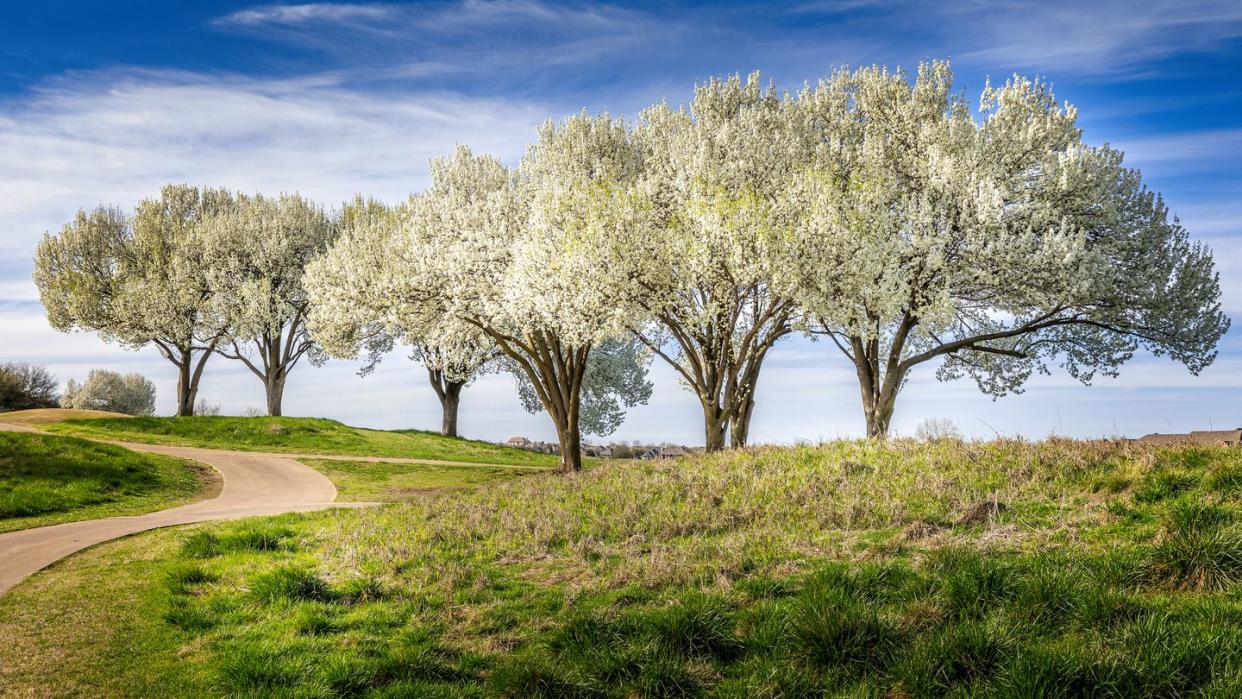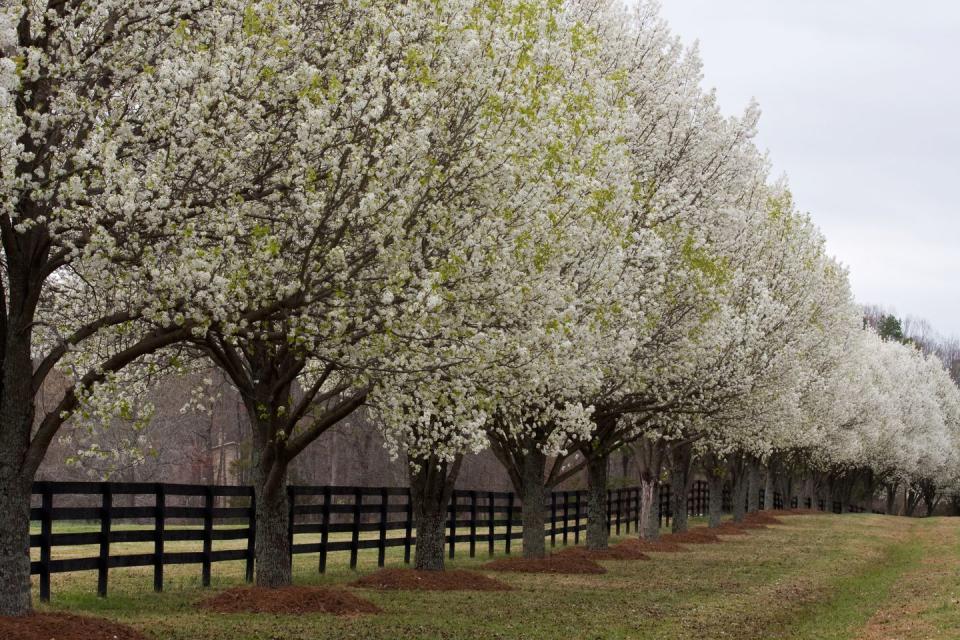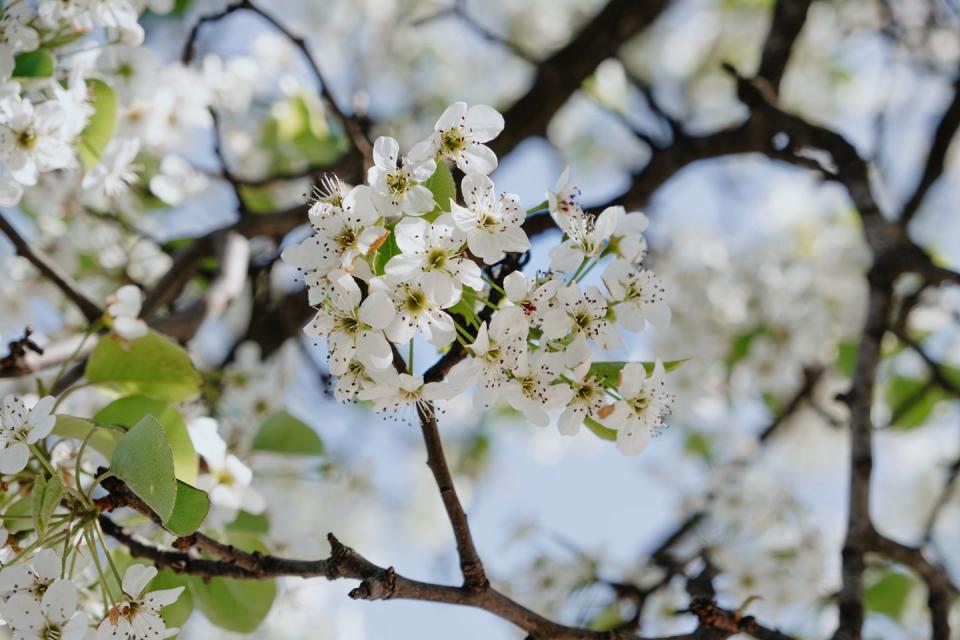These Flowering Trees Are Actually Banned in Some States

"Hearst Magazines and Yahoo may earn commission or revenue on some items through these links."
The Bradford pear tree is a tale of good intentions gone bad. This common flowering tree does have attractive qualities. “It’s one of the first trees to flower in the spring before it has leaves,” Greg Huber, Georgia Certified Landscape and Plant Professional program coordinator at the Center for Urban Agriculture at the University of Georgia, says. “It’s also easy to grow and adaptable to a variety of soil types.” So why does it have people calling for it to be banned and for existing ones to be cut down? Well, those positive traits don’t make up for the Bradford pear’s less attractive ones. Read on to learn about the Bradford pear tree’s history and problems, and get expert advice on what to plant instead.
Bradford Pear Tree History
Let’s start with its ancestor, the Callery pear (Pyrus calleryana), which was first introduced in North America in the early 20th century from Asia. It was imported for breeding programs to increase hardiness in the common pear, which was being wiped out by disease. Admired for its toughness and fast growth, the Callery pear was also used to create new ornamental varieties, such as Bradford pear.
First commercially available in the 1960s, the pretty Bradford pear quickly became a favorite of landscapers and homeowners because of its fluffy white flowers, symmetrical shape, glossy foliage, and autumn color. Bradford pears soon lined neighborhoods and city blocks.
Bradford Pear Tree Problems
Too much of a good thing is never a great idea. Shortly after the Bradford pear became popular, problems began to appear, Huber says. For starters, the flowers stink—as in, smelly, rotting fish stench. A whole row of these pungent flowering trees in bloom isn’t particularly pleasant.
The Bradford pear also has a major structural flaw. “The upright branching habit makes it prone to storm damage from wind, snow, and ice,” Huber says. Its narrow crotch angles eventually cause the tree to split from storms or even from its own weight.
But the absolute biggest problem is that Bradford trees have become an invasive species. “They compete with native plants for sunlight and nutrients and displace the native species,” Huber says. Nowadays, you’ll see hundreds of these trees in bloom along highways and in fields, forming thickets that crowd out native plants.

Why Are Bradford Pears Invasive?
While the Bradford pear tree is a sterile cultivar that can’t pollinate itself, it can cross-pollinate with other types of pear trees to create a wild hybrid tree. These vigorous hybrids produce fruit that birds and other animals eat; they then poop out the seeds, spreading them far and wide. Bradford pears also produce suckers, small seedlings that sprout up near their base, which can grow and cross-pollinate with other pears, multiplying the problem of wild hybrids, Huber says.
Most of these wild hybrids produce dangerous thorny spurs, which can reach four inches long. The thorns are sharp enough to injure livestock or puncture tractor tires and make mowing or controlling these trees a huge problem, Huber says.
And while pollinators visit the flowers on Bradford pears, few insects use the leaves, which is an issue because many birds depend on leaf-eating caterpillars and other insects to feed their babies. As more and more wild hybrids occur, they crowd out the native plants that birds and other wildlife depend on.
Bradford Pear Tree Bans and Restrictions
You can still buy all types of Callery pears—including varieties known as 'Cleveland Select,' 'Chanticleer,' 'Aristocrat,' 'Autumn Blaze,' and many others—almost anywhere, including big-box retailers and online nurseries, but planting them is a bad idea. In fact, many states such as Virginia, Minnesota, and Ohio have declared them invasive and will no longer allow them to be sold after a certain date.
States don’t require homeowners to remove existing Bradford pears, but some, such as North Carolina and South Carolina, have established “bounties” for homeowners who remove existing Bradford pears, offering saplings of native trees you can plant instead. Check with your local university co-op extension service to see what’s happening in your state.
How to Remove a Bradford Pear Tree
If you’d like to get rid of an existing Bradford pear tree (especially before it reaches its mature height of 30 to 60 feet tall), you’ll need to cut it down and treat the stump with herbicide. Baby trees can be pulled up by hand, but be sure to remove the roots, or it will re-sprout. Consult an arborist for assistance if you’re not sure if you have a Callery pear or if it’s a large tree you can't take down yourself.

What to Plant Instead of a Bradford Pear Tree
There are many beautiful native trees that are better alternatives with pretty flowers, autumn color, and attractive forms, Huber says. Just be sure to choose ones that will survive winters in your USDA Hardiness zone:
Small Understory Trees (Part Shade), 10 to 15 Feet Tall
Dogwood (Cornus florida), USDA zones 5 to 9
Redbud (Cercis canadensis), USDA zones 4 to 9
Kousa Dogwood (Cornus kousa), USDA zones 5 to 8
Small Trees (Full Sun), 15 to 25 Feet Tall
American Fringetree (Chionanthus virginicus), USDA zones 3 to 8
Star Magnolia (Magnolia stellata), USDA zones 5 to 9
Saucer Magnolia (Magnolia x soulangiana), USDA zones 5 to 9
Serviceberry (Amelanchier spp), USDA zones 4 to 9
Follow House Beautiful on Instagram and TikTok.
You Might Also Like

